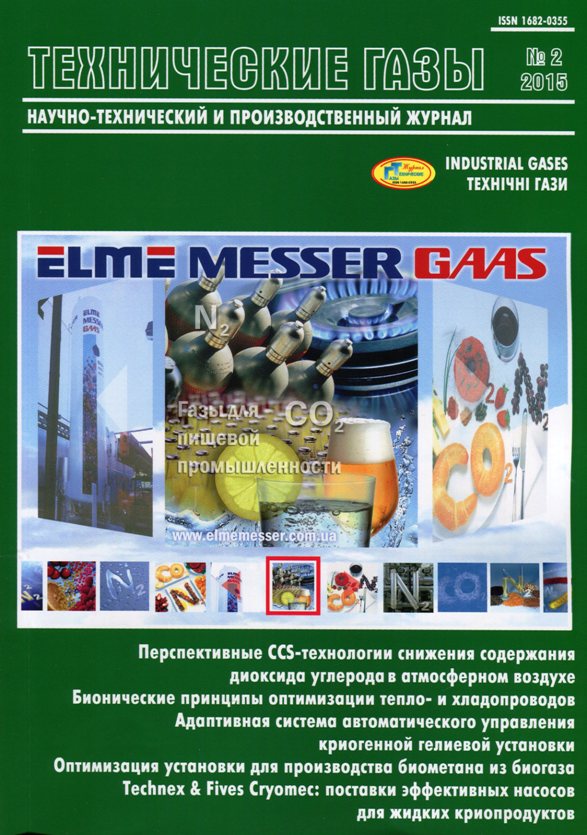ПЕРСПЕКТИВИ ВДОСКОНАЛЕННЯ ТА ШИРОКОГО ВИКОРИСТАННЯ CSS-ТЕХНОЛОГІЙ
DOI:
https://doi.org/10.18198/j.ind.gases.2015.0767Ключові слова:
Діоксид вуглецю, Парниковий газ, Глобальне потепління, Абсорбція, Адсорбція, Регенерація, Повітря, Концентрація, Установка, Технологія, Емісія, Витяг СО2 з повітряАнотація
У теперешнiй час для зниження викидів парникових газів у навколишнє середовище на великих ТЕС застосовують CCS-технологію (Carbon Capture and Storage або Carbon Capture and Sequestration). Це дозволяє знижувати темп зростання концентрації СО2 в атмосфері при безперервному збільшенні виробництва електроенергії. Для вирішення глобальної проблеми необхідно розробляти та широко впроваджувати й інші перспективні CCS-технології, але призначені для безпосереднього видалення СО2 з повітря. У зв'язку з цим розглянуто кілька інноваційних проектів. Наведено схеми, характеристики та опис установок, що реалізують CCS-технологію прямого видалення СО2 з повітря.
Посилання
[Electronic resource]: http://www.c2es.org.
[Electronic resource]: http://www.iea.org.
[Electronic resource]: http://www.energy.gov.
Boot-Handford M.E., Abanades J.C., Anthony E.J. et al. (2014). Carbon capture and storage update// Energy & Environmental Science. — No. 7. — P. 130-189.
Caldeira K., Bala G., Cao L. (2013). Annual Review of Earth and Planetary Sciences// The Science of Geoenginee-
ring. — V. 41. — Р. 231-256.
[Electronic resource]: http://www.noaa.gov.
Lavrenchenko G.K., Kopyitin A.V. (2013). Modern technology to extract CO2 from the flue gas of thermal power plants// Tekhnicheskie Gasy. [Industrial Gases]. — № 1. — С. 40-51. (Rus.).
Lavrenchenko G.K., Kopyitin A.V. (2011). New technologies of extraction CO2 from smoke gases of thermoelectric power stations// Tekhnicheskie Gasy. [Industrial Gases]. — № 2. — P. 32-42. (Rus.).
[Electronic resource]: http://www.skyonic.com.
[Electronic resource]: http://www.aacog.com.
[Electronic resource]: http://www.carbonengineering.com.
Holmes G., Keith D.W. (2012). An air-liquid contactor for large-scale capture of CO2 from air/ Phil. Trans. R. Soc. A. — V. 370. — P. 4380-4403.
[Electronic resource]: http://www.virginearth.com/ 2015/03/carbon-engineering-breaks-ground-on-new-pilot-demonstration-plant.html.
House, K. Z., Baclig, A. C., Ranjan, M., et al. (2011). Economic and energetic analysis of capturing CO2 from ambient air// Proc. Natl Acad. Sci. USA. — V. 108. — P. 428-433.
[Electronic resource]: http://www.globalthermostat.com.
[Electronic resource]: http://www.businessinsider.com/ global-thermostat-carbon-capture-tech-2013-4.html.
[Electronic resource]: http://www.technologyreview.com/ featuredstory/531346/can-sucking-CO2-out-of-the-atmosphere-really-work.html.
Chichilnisky G., Eisenberger P. (2011). Carbon Nega-
tive Power Plants// CryoGas International. — May. — Р. 36.
Chichilnisky G., Eisenberger P. (2009). Energy se-
curity, economic development and global warming: addressing short and long term challenges// Int. J. Green Economics. — V. 3. — No. 3/4. — Р. 414-446.
[Electronic resource]: http://www.climeworks.com.
Wurzbacher J.A., Gebalda Ch., Steinfeld А. (2011). Separation of CO2 from air by temperature-vacuum swing adsorption using diamine-functionalized silica gel// Energy Environ. Sci. — V. 4. — P. 3584-3592.
Wang X., Ma X., Schwartz V. et al. (2012). A solid molecular basket sorbent for CO2 capture from gas streams with low CO2 concentration under ambient conditions// Phys. Chem. Chem. Phys. — V. 14. — P. 1485-1492.
Goeppert A., Czaun M., Prakash G.K., Olah G.A. (2012). Air as the renewable carbon source of the future: an overview of CO2 capture from the atmosphere// Energy Environ. Sci. — V. 5. — P. 7833-7853.
Goeppert A. , Zhang H., Czaun M. et al. (2014). Ea-
sily Regenerable Solid Adsorbents Based on Polyamines for Carbon Dioxide Capture from the Air// ChemSusChem. — — V. 7. — No. 5. — P. 1386-1397.
[Electronic resource]: http://www.coaway.com.
[Electronic resource]: http://www.kilimanjaroenergy.com.
[Electronic resource]: http://www.earthtimes.org/scitech/ carbon-debt-trees/1553.html.
[Electronic resource]: http://climatechange.medill.northwestern.edu/page.aspx?id=209279.html.
Babarao R., Coghlan C.J., Rankine D. et al. (2014). Does functionalisation enhance CO2 uptake in interpenetrated MOFs? An examination of the IRMOF-9 series// Chemical Communications. — V. 50. — P. 3238-3241.
[Electronic resource]: https://theconversation.com/mof-the-chart-why-a-record-breaking-surface-area-matters-9915.html.
Lin L., Kim J., Kong X. et al. (2013). Understanding CO2 Dynamics in Metal–Organic Frameworks with Open Metal Sites// Angewandte Chemie International. — V. 52. — No. 16. — Р. 4410-4413.
Wu D., McDonald T.M., Quan Z. et al. (2015). Ther-
mo-dynamic complexity of carbon capture in alkylamine-functionalized metal–organic frameworks// Journal of Materials Chemistry. A. — No. 3. — Р. 4248-4254.
McDonald T.M., Mason J.A., Kong X. et al. (2015). Cooperative insertion of CO2 in diamine-appended metal-organic frameworks// Nature. — V. 519. — No. 7543. — P. 303-308.
[Electronic resource]: http://www.nasa.gov/content/ oco-2-lifts-off-on-carbon-counting-mission.html.
##submission.downloads##
Номер
Розділ
Ліцензія
ЛІЦЕНЗІЙНИЙ ДОГОВІР
Після прийому статті до публікації редакція згідно з вимогами наукометричних баз кожному з авторів направляє ліцензійний договір про відступлення і передачу в управління авторських прав. Підпису автора (авторів) бажано скріпити печаткою відділу кадрів установи, в якій працює автор (автори), або печаткою факультету.
Редакція відсилає авторам одну верстку для коректури. Припустимі лише ті виправлення, які призводять верстку у відповідність з вихідним текстом статті. Внесення суттєвих змін не допускається. Верстку слід вислати до редакції протягом доби з моменту отримання.

